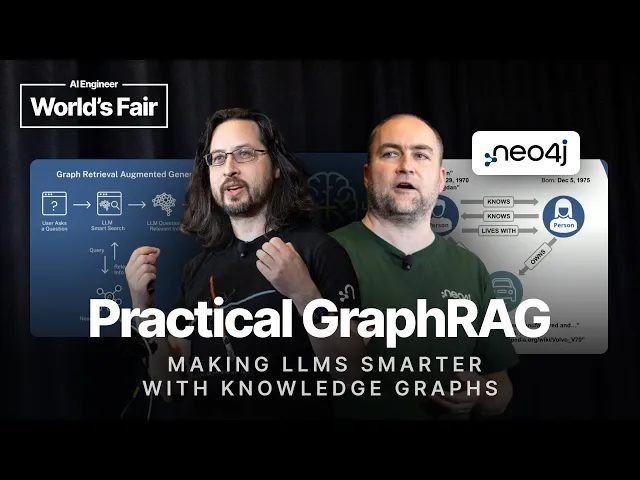Practical GraphRAG: Making LLMs smarter with Knowledge Graphs — Michael, Jesus, and Stephen, Neo4j

Smarter LLMs through knowledge graphs
In the rapidly evolving landscape of AI, finding ways to enhance large language models (LLMs) with deeper contextual understanding has become a critical frontier. A recent discussion featuring experts from Neo4j introduces GraphRAG, an innovative approach that combines retrieval-augmented generation with the structural advantages of knowledge graphs. This technique promises to overcome significant limitations in how LLMs access and reason with information, potentially transforming enterprise AI applications.
Key Points
-
GraphRAG addresses the "hallucination problem" in LLMs by providing structured knowledge context through graph databases, allowing for more accurate information retrieval and reasoning.
-
Unlike traditional vector embeddings that work in isolation, knowledge graphs maintain relationships between concepts, enabling more nuanced understanding of complex domains and hierarchical information.
-
The approach offers practical advantages like improved query formulation, dynamic context expansion, and domain-specific reasoning that traditional RAG implementations struggle with.
Why Knowledge Graphs Matter for LLM Intelligence
The most compelling insight from this discussion is how knowledge graphs fundamentally change what's possible with LLMs by providing relationship-based context rather than just similarity-based matching. Traditional RAG implementations rely heavily on embedding vectors that capture semantic similarity but miss crucial structural relationships between concepts. When an LLM needs to answer complex questions requiring multi-hop reasoning or understanding hierarchical relationships, traditional approaches falter.
This matters tremendously in enterprise contexts where accuracy isn't just preferable—it's essential. Consider financial services, healthcare, or manufacturing, where understanding the relationship between entities (customers and products, drugs and conditions, components and systems) determines the value of AI-generated insights. As organizations race to implement generative AI, those who leverage knowledge graphs will likely achieve significantly more reliable and sophisticated applications.
Beyond the Discussion: Real-World Applications
One fascinating application not deeply covered in the discussion is in customer service automation. Take a telecommunications company managing millions of customer relationships. A traditional RAG system might match a customer complaint about internet speed with similar past issues based on textual similarity. However, a GraphRAG implementation could immediately identify the customer's specific hardware model, their service tier, recent area outages, and historical performance patterns—all represented as connected nodes in a knowledge graph. The LLM can then generate responses that take into account these relationships rather than just pattern-matching against
Recent Videos
How To Earn MONEY With Images (No Bullsh*t)
Smart earnings from your image collection In today's digital economy, passive income streams have become increasingly accessible to creators with various skill sets. A recent YouTube video cuts through the hype to explore legitimate ways photographers, designers, and even casual smartphone users can monetize their image collections. The strategies outlined don't rely on unrealistic promises or complicated schemes—instead, they focus on established marketplaces with proven revenue potential for image creators. Key Points Stock photography platforms like Shutterstock, Adobe Stock, and Getty Images remain viable income sources when you understand their specific requirements and optimize your submissions accordingly. Specialized marketplaces focusing...
Oct 3, 2025New SHAPE SHIFTING AI Robot Is Freaking People Out
Liquid robots will change everything In the quiet labs of Carnegie Mellon University, scientists have created something that feels plucked from science fiction—a magnetic slime robot that can transform between liquid and solid states, slipping through tight spaces before reassembling on the other side. This technology, showcased in a recent YouTube video, represents a significant leap beyond traditional robotics into a realm where machines mimic not just animal movements, but their fundamental physical properties. While the internet might be buzzing with dystopian concerns about "shape-shifting terminators," the reality offers far more promising applications that could revolutionize medicine, rescue operations, and...
Oct 3, 2025How To Do Homeless AI Tiktok Trend (Tiktok Homeless AI Tutorial)
AI homeless trend raises ethical concerns In an era where social media trends evolve faster than we can comprehend them, TikTok's "homeless AI" trend has sparked both creative engagement and serious ethical questions. The trend, which involves using AI to transform ordinary photos into images depicting homelessness, has rapidly gained traction across the platform, with creators eagerly jumping on board to showcase their digital transformations. While the technical process is relatively straightforward, the implications of digitally "becoming homeless" for entertainment deserve careful consideration. The video tutorial provides a step-by-step guide on creating these AI-generated images, explaining how users can transform...
